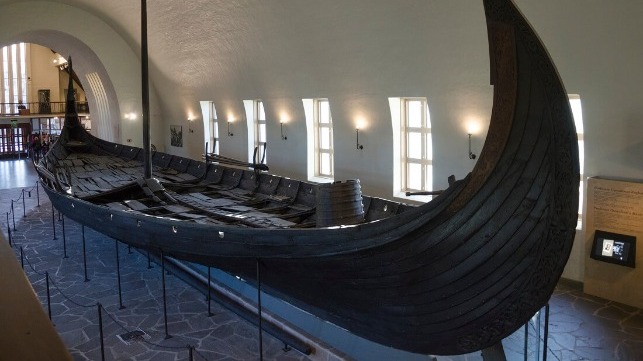Researchers Use Tapestries to Piece Together Viking Ship's Secrets

[By Bjørn Kvaal]
The Oseberg Ship is one of the three best-preserved Viking ships in the world. It was 22 metres long and 5 metres wide. On board, there was room for 30 rowers, one helmsman and one lookout.
The ship was discovered in one of the most famous ship graves from the Viking Age – the most richly equipped grave from this period in Europe.
Although most of the ship and the grave goods were crushed and broken into small pieces, the skeletons of two women and their heirlooms were found. These included wagons, looms, kitchen equipment and chests containing fragments of fabric.
Archaeologists discovered over 80 fragments from one or more tapestries in the Oseberg ship. Photo: George Alexis Pantos, Cultural History Museum
Warriors and religion
Among the archaeologists’ finds during the excavation outside Tønsberg in 1904 were over 80 fragments from one or more tapestries. They may have been made of wool mixed with plant fibres.
Among the motifs on the fabrics are male and female warriors and religious, ceremonial acts. The colours and not least the motifs on the tapestries are now being pieced back together. A multidisciplinary group of researchers is using imaging techniques and analysis methods to provide new interpretations of the motifs.
Research on dyes and the degradation of fabrics can provide answers about the original colouring and where the materials were made.
Tapestries were probably used to decorate bedrooms, burial chambers, or halls during festive occasions for people of high status. The fact that they were in the burial mound with the Oseberg Ship indicates that the two women were wealthy and that they were to take the tapestries with them into the afterlife.
You might also like: Unique Middle Ages tapestry gives insight into medieval times
No need to move the fragments
In order to find the complete motif on the textile, the fragments of the tapestry must be pieced together in the right order. The TexRec project is funded by the Research Council of Norway and involves researchers from several countries. They are conducting chemical analyses of the dye the Vikings used and investigating textile preservation.
Davit Gigilashvili. Photo: NTNU
Colourlab at NTNU in Gjøvik, archaeologists from the Museum of Cultural History and textile conservators from the University Museum of Bergen are collaborating on piecing together the fragments of textile from the Oseberg Ship to create a coherent story.
“The pieces are extremely fragile and archaeologists are not able to just physically move them around. Therefore, we are developing software where photographs of the fragments can be uploaded and then moved around digitally. We can also increase the contrast of the images to make patterns more visible to the human eye. This is how we can digitally solve this jigsaw puzzle,” says Davit Gigilashvili.
As a postdoctoral fellow at the Department of Computer Science at NTNU in Gjøvik, Gigilashvili finds it an adventure to be involved in the work.
“It is a jigsaw puzzle that is going to be really exciting to solve because no one in the world knows the answers yet,” he says.
Six metres below ground
When you do an ordinary jigsaw puzzle, you have the finished picture on the lid of the box. But what happens when the motif and pieces are missing, the colours have faded, and many of the pieces are damaged after having been buried six metres below ground and pillaged by grave robbers?
“We don’t know how many tapestries there were in the Oseberg Ship before the motifs began to disintegrate. In other words, when we compare two fragments, there is no guarantee that they belonged to the same piece of fabric,” says Gigilashvili.
Therefore, the researchers have used a computer to find solutions to the jigsaw puzzle with the help of artificial intelligence. Algorithms identify each individual piece of ancient fabric and motif, and see it in relation to other fragments.
Irreplaceable humans
Machine learning models, however, have not been able to provide very good answers. They have seen millions of photos of cats and dogs, buses and bicycles, and have learned to distinguish between them, but they have never seen textiles from the Viking Age. As a result, they often make mistakes.
Computer technology is coordinated with the knowledge of archaeologists. They make assumptions about which fragments belong together, and comment on whether the results make sense.
In a research article, Gigilashvili and co-authors argue that large datasets of images are needed to train the models. But what happens when computers and software are not always helpful?
The solution is that computer technology must be coordinated with the knowledge of archaeologists. They make assumptions about which fragments belong together, and comment on whether the results make sense.
“Archaeologists can detect similarities in style and manufacturing techniques that can indicate that the fragments belong together. Machine learning models should then draw inspiration from this and imitate the behaviour of archaeologists. Although computers can provide interesting suggestions and valuable help, human expertise in this work is irreplaceable and will remain so for the foreseeable future,” says Gigilashvili.
New Viking knowledge
Piecing together 1200-year-old fragments of tapestry can provide new knowledge about the Vikings’ lives.
Gigilashvili believes that, as well as helping archaeologists, the software can also be used in computer games and teaching about cultural heritage and what life was like in the Viking Age.
This article appears courtesy of Gemini News and may be found in its original form here.
The opinions expressed herein are the author's and not necessarily those of The Maritime Executive.
